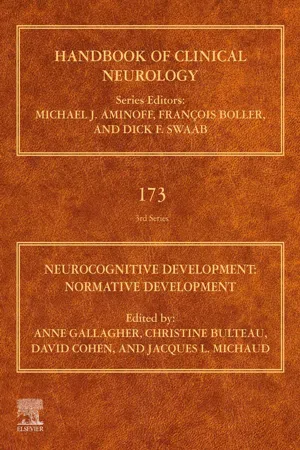
- 532 pages
- English
- ePUB (mobile friendly)
- Available on iOS & Android
About This Book
This is one of a two-volume work on neurocognitive development, focusing separately on normative and non-normative development. The normative volume focuses on neurology, biology, genetics, and psychology of normative cognitive development. It covers the development of intellectual abilities, visual perception, motor function, language, memory, attention, executive function, social cognition, learning abilities, and affect and behavior. The book identifies when and how these functions develop, the genetics and neurophysiology of their operation, and their evaluation and assessment in clinical practice.
This book will serve as a comprehensive reference to researchers in cognitive development in neuroscience, psychology, and medicine, as well as to clinicians and allied health professionals focused on developmental disabilities (child neurologists, pediatric neuropsychologists, child psychiatrists, speech and language therapists, and occupational therapists.)
- Summarizes research on normative neurocognitive development
- Includes intellectual abilities, language, memory, attention, motor function, and more
- Discusses genetics and environmental influences on development
- Provides interdisciplinary information of use to both researchers and clinicians
Frequently asked questions
Chapter 11: Intellectual abilities
* Correspondence to: Roberto Colom, Ph.D., Biological and Health Psychology, Universidad Autonoma de Madrid, Facultad de Psicologia, Madrid 28049, Spain. Tel: + 34-914-974-114, Fax: +34-91-497-86-38. email address: [email protected]
Abstract
Keywords
Definition of Intelligence
| Criterion measure | Predictive validity |
|---|---|
| Educational attainment | 0.56 |
| Job performance | 0.53 |
| Skill acquisition in work training | 0.38 |
| Becoming a leader of a group | 0.25 |
| Income | 0.20 |
| Having anorexia nervosa | 0.20 |
| Participation in group activities | 0.18 |
| Creativity | 0.17 |
| Traffic accident involvement | − 0.12 |
| Having schizophrenia | − 0.26 |

Table of contents
- Cover image
- Title page
- Table of Contents
- Copyright
- Handbook of Clinical Neurology 3rd Series
- Foreword
- Preface
- Contributors
- Section I: Introduction to neurodevelopmental disabilities
- Section II: Biological basis of typical neurodevelopment
- Section III: Plasticity, vulnerability and evolutionary constraints of the developing brain
- Section IV: Neuroscientific basis of typical functional neurodevelopment
- Section V: Etiologies of neurodevelopmental disorders
- Index